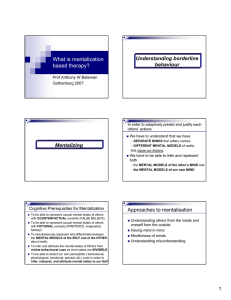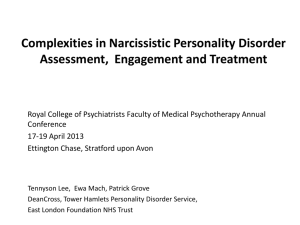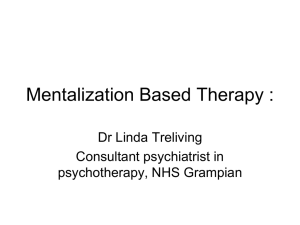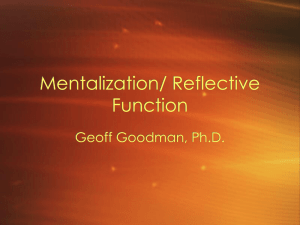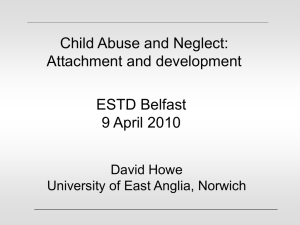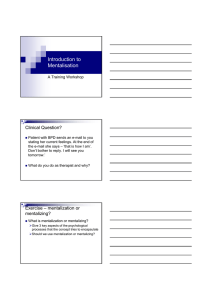Introduction to Mentalization Mindblindness A Training Workshop
advertisement
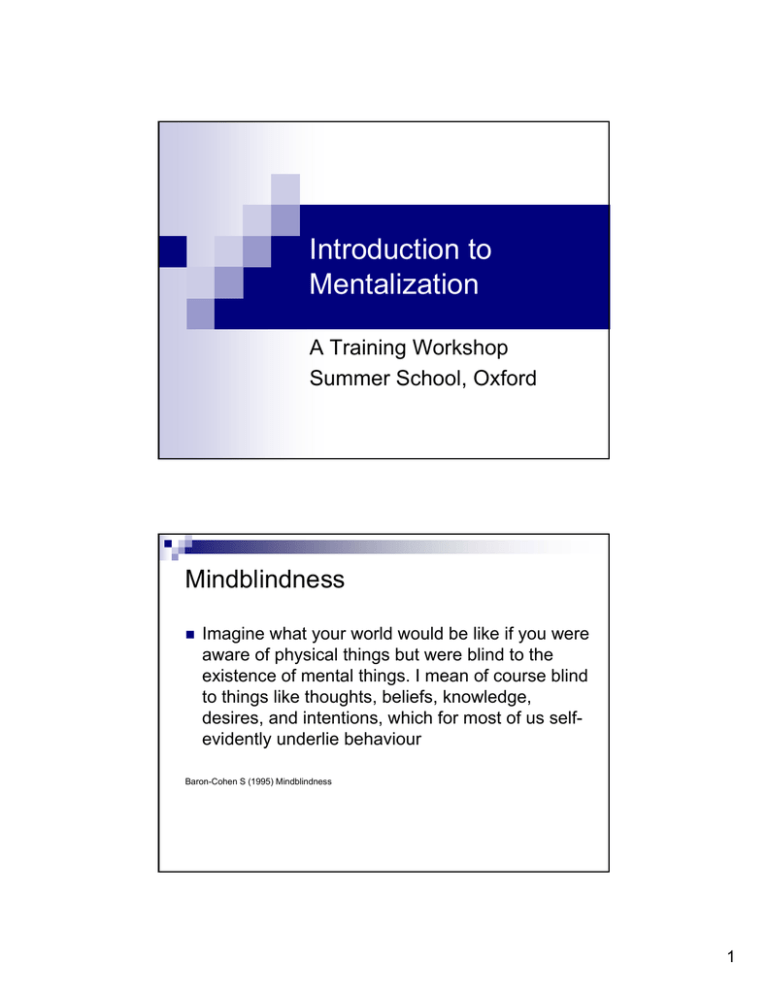
Introduction to Mentalization A Training Workshop Summer School, Oxford Mindblindness Imagine what your world would be like if you were aware of physical things but were blind to the existence of mental things. I mean of course blind to things like thoughts, beliefs, knowledge, desires, and intentions, which for most of us selfevidently underlie behaviour Baron-Cohen S (1995) Mindblindness 1 The Artful use of Science To do anything well you must have the humility to bumble around a bit, to follow your nose, to get lost, to goof. Have the courage to try an undertaking and possibly do it poorly. Unremarkable lives are marked by the fear of not looking capable when trying something new. Epictetus, Manual Mentalizing: A new word for an ancient concept Implicitly and explicitly interpreting the actions of oneself and other as meaningful on the basis of intentional mental states (e.g., desires, needs, feelings, beliefs, & reasons) 2 Introduction to theory of mentalisation The normal ability to ascribe intentions and meaning to human behaviour Ideas that shape interpersonal behaviour Make reference to emotions, feelings, thoughts, intentions, desires Shapes our understanding of others and ourselves Central to human communication and relationships Underpins clinical understanding, the therapeutic relationship and therapeutic change Mentalizing: further definitions and scope To see ourselves from the outside and others from the inside Understanding misunderstanding Having mind in mind Past, present, and future Introspection for subjective selfconstruction – know yourself as others know you but also know your subjective self 3 Characteristics of mentalising Central concept is that internal states (emotions, thoughts, etc) are opaque We make inferences about them But inferences are prone to error Overarching principal is to take the “inquisitive stance” = Interpersonal behaviour characterised by an expectation that one’s mind may be influenced, surprised, changed and enlightened by learning about another’s mind Mentalizing: Implicit ‘v’ Explicit IMPLICIT Perceived Nonconscious Nonverbal Unreflective e.g. mirroring EXPLICIT Interpreted Conscious Verbal Reflective e.g. explaining 4 Parallel contributions to mentalizing: Meeting of minds attachment & arousal PATIENT mentalization attachment & arousal mentalizing Developmental competence Current performance HEALTH CARE SYSTEM mentalizing Current performance attachment & arousal CLINICIAN mentalization Developmental competence attachment & arousal Failures of imagination in mindblindness Dehumanising Subjectivity & humanity Demonizing Concrete & Egocentric Restrained imagination Imaginary & projective Mentalizing Distorted mentalizing Non-mentalizing 5 Mentalizing and psychopathy: Compart-mentalization Psychopathy entails elements of intact mentalizing Partial mindblindness: ¾ Failure of imaginative empathy ¾ Failure to identify with victim’s distress ¾ Mind uninfluenced and unchanged easily – control and protection of self from shame/humiliation paramount ¾ Distorted mentalizing – paranoid demonizing e.g. interpreting the child’s frustrating behaviour as intended to torment the parent Being misunderstood Although skill in reading minds is important, recognising the limits of one’s skill is essential First, acting on false assumptions causes confusion Second, being misunderstood is highly aversive Being misunderstood generates powerful emotions that result in coercion, withdrawal, hostility, over protectiveness, rejection 6 Examples from the Reading the Mind in the Eyes (Baron-Cohen et al., 2001) surprised joking sure about something happy Examples from the Reading the Mind in the Eyes (Baron-Cohen et al., 2001) friendly surprised sad worried 7 The development of regulated affect Psychological Self: nd 2 Order Representation Physical Self: Primary Representations …..Symbolization of Emotion Representation of self-state: Internalization of object’s image con ting ent disp exp lay met ressio abo n Expression lize of d af fect symbolic binding of internal state Reflection signal Constitutional self in state of arousal rbal non-ve on si expres Infant Resonance CAREGIVER Fonagy, Gergely, Jurist & Target (2002) With apologies to Gergely & Watson (1996) Duration of Looking at Self During Three Phases of Modified Still Face Procedure Insecure (n=47) Secure (n=92) % looking at self 1.4 1.2 1 0.8 0.6 0.4 0.2 0 Mother accessible Mother stillface Mother accessible again (Gergely, Fonagy, Koos, et al., 2004) F(interaction)=6.90, df=2,137, p<.0001 8 Duration of Looking at Self During Three Phases of Modified Still Face Procedure % looking at self Organized (n=119) Disorganized (n=20) 1.8 1.6 1.4 1.2 1 0.8 0.6 0.4 0.2 0 Mother accessible Mother stillface Mother accessible again (Gergely, Fonagy, Koos, et al., 2004) F(interaction)=12.00, df=2,137, p<.0001 The implication of the temporary loss of mentalising 1. 2. 3. Psychic Equivalence Pretend Mode Teleological Stance 9 The Modes of Psychic Reality That Antedate Mentalisation and Characterize Suicide/Self-harm Psychic equivalence: ¾Mind-world isomorphism; mental reality = outer reality; internal has power of external ¾Experience of mind can be terrifying (flashbacks) ¾Intolerance of alternative perspectives (“I know what the solution is and no one can tell me otherwise ”) ¾Self-related negative cognitions are TOO REAL! (feeling of badness felt with unbearable intensity) The Modes of Psychic Reality That Antedate Mentalisation and Characterize Suicide/Self-harm Pretend mode: ¾ Ideas form no bridge between inner and outer reality; mental world decoupled from external reality ¾ Linked with emptiness, meaninglessness and dissociation in the wake of trauma ¾ Lack of reality of internal experience permits selfmutilation and states of mind where continued existence of mind no longer contingent on continued existence of the physical self ¾ In therapy endless inconsequential talk of thoughts and feelings o The constitutional self is absent Î feelings do not accompany thoughts 10 The Modes of Psychic Reality That Antedate Mentalisation and Characterize Suicide/Self-harm Teleological stance: ¾ Expectations concerning the agency of the other are present but these are formulated in terms restricted to the physical world ¾ A focus on understanding actions in terms of their physical as opposed to mental outcomes ¾ Patients cannot accept anything other than a modification in the realm of the physical as a true index of the intentions of the other. ¾ Only action that has physical impact is felt to be able to alter mental state in both self and other o Manipulative physical acts (self-harm) o Demand for acts of demonstration (of affection) by others Understanding suicide and self-harm in terms of the temporary loss of mentalisation Figure 2.x Understanding BPD in terms of the suppression of mentalization Temporary Failure of Mentalisation Pretend Mode Psychic Equivalence Teleological Mode Pseudo Mentalisation Concrete Understanding Misuse of Mentalisation Dysfunctions of Interpersonal Relationships Suicide Self-Harm Impulsive Acts of Violence loss Î attachment needs Îfailure of mentalisation Îintensification of unbearable experienceÎ Îdissociation Îteleological solutions to crisis of agentive self 11 Clinical Implications Dysregulation of attentional capacities With individuals whose attachment relationships have been disorganized we may anticipate quite severe problems in affect regulation and attentional control along with profound dysfunctions of attachment relationships Exploratory psychotherapy techniques are likely to dysregulate the patient’s affect It is wise to anticipate difficulties in effortful control 12 Disorganisation of self The therapist should be alert to subjective experiences indicating discontinuities in self structure (e.g. a sense of having a wish/belief/feeling which does not ‘feel like their own’.) It is inappropriate to see these states of minds as if they were manifestations of a dynamic unconscious and as indications of the ‘true’ but ‘disguised’ or ‘repressed’ wish/belief/feeling of the patient The discontinuity in the self will have an aversive aspect to most patients leading to a sense of discontinuity in identity (identity diffusion) Projection of alien self Patients will try to deal with discontinuous aspects of their experience by externalisation (generating the feeling within the therapist) The tendency to do this had been established early in childhood It is not going to be reversed simply by bringing conscious attention to the process – therefore interpretation of it is mostly futile 13 Projective identification Disowned mental states may include the internalisation of a frankly malevolent state of mind. Patient should be given some limited opportunity to create relationships where they involve the other in enactments Their experience is of a hostile/ persecutory state that must be got rid of to stop the experience of attack by the self from within The degree to which patients engage in externalisation must be carefully controlled Too many regressive enactments will undermine opportunity for using the relationship to enhance mentalisation Core morbidities The interrelated deficits associated with BPD include ¾ ¾ ¾ ¾ Impulsiveness Emotion regulation Relationship problems Identity formation Problems in mentalization may relate to any or all of these deficits Typical problems associated with BPD may be direct consequences of not perceiving the mental states of other with sufficient accuracy OR the re-emergence of nonmentalising modes of social cognition OR both 14 Context specificity The quality of mentalisation varies widely in BPD, largely as a function of the patient’s interpersonal context The clinician should monitor several parameters in relation to the quality of mentalisation ¾ Level of emotional arousal ¾ Intensity of attachment ¾ Need to avoid perceived threat from hostile other Mentalisation is at least in part a function of the prefrontal cortex and any activity that leads to an inhibition of this part of the brain is likely to lead to the loss of mentalisation ¾ Hyperactivation of the attachment system ¾ High levels of arousal Mentalisation may be defensively inhibited in specific (traumatogenic) relational contexts Psychic equivalence Characterised by conviction of being right that makes entering into Socratic debates mostly unhelpful Patients commonly assume that they know what the therapist is thinking - claiming primacy for introspection (i.e. saying that one knows one’s own mind better than the patient) will lead to fruitless debate The rigid character of the patient’s thoughts are made more aversive by hostile presuppositions of the patient Therapist may make ill advised attempt to ‘defend’ position Grandiosity and idealization are also expectable consequences of an unquestioning mind 15 Psychic equivalence It is not the action itself that carries most meaning in this mode but deviation from action that is contingent with the patient’s wishes Self-harm, suicide attempts and other dramatic actions tend to bring about contingent change in the behaviour of most people - patient experiences a sense of being cared about Misuse of mentalisation may be linked to such pseudo-manipulativeness and involve realistic risk of harm to the patient or interactive partner Iatrogenesis Therapeutic interventions run the risk of exacerbating rather than reducing the reasons for temporary failures of mentalising Non-mentalising interventions tend to place the therapist in the expert role declaring what is on the patients’ mind which can be dealt with only by denial or uncritical acceptance To enhance mentalising the therapist should state clearly how he has arrived at a conclusion about what the patient is thinking or feeling Exploring the antecedents of mentalisation failure is sometimes but by no means invariably helpful in restoring the patient’s ability to think 16 Therapist stance Therapist/Patient Problem THERAPY STIMULATES ATTACHMENT SYSTEM EXPLORATION DISCONTINUITY OF SELF ATTEMPT TO STRUCTURE by EFFORT TO CONTROL SELF &/OR OTHER 17 Therapist/Patient Problem ATTEMPT TO STRUCTURE by EFFORT TO CONTROL SELF &/OR OTHER RIGID SCHEMATIC REPRESENTATION NON-MENTALIZING CONCRETE MENTALIZING (PSYCHIC EQUIVALENCE) PSEUDO MENTALIZING (PRETEND) MISUSE OF MENTALIZING Therapist Stance Not-Knowing ¾ Neither therapist nor patient experiences interactions other than impressionistically ¾ Identify difference – ‘I can see how you get to that but when I think about it it occurs to me that he may have been preoccupied with something rather than ignoring you’. ¾ Acceptance of different perspectives ¾ Active questioning Monitor you own mistakes ¾ Model honesty and courage via acknowledgement of your own mistakes o Current o Future ¾ Suggest that mistakes offer opportunities to re-visit to learn more about contexts, experiences, and feelings 18 Therapist Stance Reflective enactment ¾Therapist’s occasional enactment is acceptable concomitant of therapeutic alliance ¾Own up to enactment to rewind and explore ¾Check-out understanding ¾Joint responsibility to understand overdetermined enactments Therapist Stance Implicit Mentalization The therapist is continually constructing and reconstructing an image of the patient, to help the patient to apprehend what he feels Mentalizing in psychotherapy is a process of joint attention in which the patient’s mental states are the object of attention Neither therapist nor patient experiences these interactions other than impressionistically 19 Components of mentalizing the transference Validation of experience Exploration in the current relationship Accepting and exploring enactment (therapist contribution, therapist’s own distortions) Collaboration in arriving at an understanding Present an alternative perspective Monitor the patient’s reaction Explore the patient’s reaction Interventions: Mentalizing the Transference Dangers of using the transference ¾Avoid interpreting experience as repetition of the past or as a displacement. This simply makes the borderline patient feel that whatever is happening in therapy is unreal ¾Thrown into a pretend mode ¾Elaborates a fantasy of understanding with therapist ¾Little experiential contact with reality ¾No generalization 20 Mentalisation and Aggression An evolutionary framework Interpersonal violence is an important evolutionary adaptation. ¾In certain human environments it is likely to contribute materially to the survival of the individual's genes. ¾In other contexts it is seriously maladaptive o it undermines the possibility of safe collaboration o the optimization of human capacities for meaning generation, communication and creativity. 21 An evolutionary framework Human infants are born with the potential to be violent. In the majority of cases this potential is not fulfilled They gradually increasingly desist from physical aggression. Three apparently contradictory findings on the development of violence Most preschoolers use physical aggression. The earlier the onset of problem behaviours, the higher the risk for continued aggression and violence Only a small proportion of individuals are persistently physically aggressive The challenge is to distinguish between the normative patterns of aggressive behaviours and the more atypical pattern that may represent a risk for future difficulties 22 NICHD study: Trajectories of physical aggression from 24 months to age 9 (n=1,195) 3% 12% 15% 70% Trajectories of Physical Aggression in Canadian Accelerated Longitudinal Study N=10,214 17% 52% 31% 23 What differentiates persistent violent trajectory? The NICHD ECCRN (2004) ¾ socio demographic risk (e.g., poverty, low maternal education, single parenting) ¾ less sensitive and involved parenting during the course of childhood Nagin and Tremblay (2001), Tremblay et al. (2004) ¾ have mothers with low levels of education. ¾ have mothers who started childbearing early Shaw et al. (2003) study ¾ Boys more fearless ¾ Experienced maternal rejection The mechanism for the development of violence: A failure of inhibition Family processes conceptualized as promoting aggression may interfere with the socialization of aggression ¾low income, low maternal education reflects family environments in which children have difficulty learning to inhibit their use of physical aggression, as well as difficulty learning alternative strategies to solve problems ¾This relationship is mediated by parenting quality 24 Aspects of Parenting Associated with Aggression Trajectories in Canadian Study Hostile ineffective parenting Hostile Ineffective parenting Positve Interaction 12 14.4 11.5 14.2 11 10.5 14 p<.03*10-47 d=.39 p<.02*10-99 d=1.88 10 13.8 9.5 13.6 9 8.5 13.4 8 13.2 7.5 7 13 Low Desister Low High stable Consistent parenting Desister High stable Family functioning Consistent parenting 15.4 9.5 15.2 9 15 p<.01*10-64 d=.46 14.8 8.5 14.6 8 14.4 7.5 p<.05*10-83 d=.53 14.2 7 14 6.5 13.8 6 13.6 Low Desister High stable Low Desister High stable p<.02*10-99 IS p<.000000000000000000000000000000 000000000000000000000000000000 0000000000000000000000000000002 OR The likelihood of five hundred 13-spade bridge hands when getting one hand with all spades would take 20 million bridge players dealing 30 hands a week 20 years to get one all-spade hand. 25 The Role of Attachment The developmental trajectory is established early on ¾ The choice has to be made because there is an evolutionary cost to following the physical aggression trajectory. Evolution uses the early attachment relationship as a signaling system to the newborn as to the kind of environment he/she might expect. ¾ An environment where caregivers do not have the time or resources to devote attention to the infant is far more likely to necessitate the later use of violence in order to ensure the survival of the individual in subsequent struggles for limited resources. John Bowlby’s Discovery: The Nature of the Attachment System 26 Attachment security at 15 and 24 months predicts aggressive behaviour at 54 months NICHD study of 1,000 mother infant pairs Secure attachment judged on bases of home observations at 24 months, predicts behavior problems, especially above-average levels of problems. ¾ close to 90% of children whose mothers rated them as having externalizing problems were insecure based on Qset ratings. Insecurity judged in laboratory assessments at 15 and 36-month predicted mothers and caregivers ratings of externalizing problems for boys. Maternal depressive symptoms predicted mothers ratings of externalizing problems. Disorganised Attachment Classification Disorganised-disoriented infants ¾freezing, hand clapping, wish to escape Arousal of attachment system Îattachment figure is haven of safety and source of stress Associated with ¾severe neglect ¾physical abuse ¾sexual abuse 27 Disorganised attachment and externalising behaviour Fear of an abusive or ill parent activates their need for proximity-seeking, which, in turn, increases their fear ¾results in a collapse of the infant’s behavioral and attentional strategies van IJzendoorn, Schuengel, and BakermansKranenberg (1999) reviewed twelve studies on 734 children and demonstrated a clear association between disorganization and externalizing problems (r = .29, p<.00001). Attachment as a Signal of Environmental Stress Where caregivers do not have the time or resources to devote attention to the infant physical aggression is more likely to be needed to ensure survival This is the mechanism for the transgenerational transmission of violent interpersonal strategies. The child’s mind and body needs to be prepared for violent competition for resources ¾ Alternative but incompatible strategies for ways of relating to others (intra-species collaboration) are sacrificed. What is sacrificed? ¾ Namely, the uniquely human capacity to envision mental states in our fellow humans in order to understand their actions. 28 The Social Brain (Lieberman , 2007) Genetics of Social Cognition: Passing ToM Battery 19% 15% 33% genetic shared environmental common to verbal 21% non-shared environmental common to verbal non-shared environmental unique to ToM 67% 45% N=120 Hughes, C., & Cutting, A. (1999) Psychological Science, 10, 429-432. N=1,116 Hughes, C., Jaffee, S. R., Happe, F., Taylor, A., Caspi, A., & Moffitt, T. E. (2005) Child Dev, 76(2), 356-370. “Bivariate model-fitting analyses yielded modest genetic effects” 29 The quality of children’s primary attachment relationship facilitates theory of mind development Number of studies reported associations between secure attachment and passing standard theory of mind tasks somewhat earlier (e.g., de Rosnay & Harris, 2002; Fonagy & Target, 1997; Fonagy, Redfern, & Charman, 1997 Harris, 1999; Meins, Fernyhough, Russell, & ClarkCarter, 1998; Raikes & Thompson, 2006; Steele, Steele, Croft, & Fonagy, 1999; Symons, 2004; Thompson, 2000; Ontai & Thompson, 2002) Not all studies find this relationship ¾ More likely to be observed for emotion understanding then ToM Oxytocin Î mind reading (Domes et al., in press) Oxytocin and performance on Mind in the Eyes test (Domes et al., in press) 30 Mentalisation and Violence Violence unfortunately requires the possibility for the temporary inhibition or decoupling of mentalisation In a social context of adversity, the child’s brain responds to the signal from the attachment system and places powerful limits on mentalisation. Mentalisation has the potential to advance culture and inhibit violence but is, at least partially, maladaptive in the context of life-and-death struggle. Creating a peaceful school learning environment Stuart W. Twemlow, Eric M. Vernberg, Edward J. Dill, John A. Sargent Peter Fonagy, Jennifer A. Mize, Todd D. Little, 31 Assumptions, Aims and Adjuncts The whole school community contributes to bullying-related dysfunction Peaceful collaboration with others requires prioritizing their subjective states, thus placing limits upon the urge to violently control the behaviour of less powerful members of the group Assumptions, Aims and Adjuncts CAPSLE aims constantly to focus on the mental states of all those involved in the power dynamics of interpersonal violence (the bystander as well as the bully and the victim) through: ¾ a positive climate campaign to draw attention to the subjective experiences of bully, victim, and bystander ¾ a classroom management plan that requires teachers to elaborate the thoughts and feelings associated with acts of aggression in the classroom ¾ a defensive martial arts program based on mindfulness ¾ peer or adult mentorship that create additional opportunities for reflective interpersonal interaction ¾ reflection time which offers opportunities for the class to consider shared immediate past experience together 32 Increasing Mentalization Should Reduce Violence: The Peaceful Schools Project 9 schools randomly assigned to ¾CAPSLE ¾School Psychiatric Consultation ¾Treatment as usual oProgrammes as usual Design ¾3 year study ¾2 years of formal manualized intervention ¾3rd year test of generalisation 19 Eligible Elementary Schools, Including 6,522 K-5th Grade Children 10 Elementary Schools Elected To Participate, Including 2,712 Children 10 Schools, including 2,712 Children, Stratified and Cluster Randomized 1,035 Children CAPSLE In 3 Schools 824 Children SPC In 3 Schools 1 School (178 Children) Withdrew From Treatment as Usual Condition 675 Children Treatment as Usual In 3 Schools Only 3rd-5th Grade Children Completed Research Instruments CAPSLE Children Participating SPC Children Participating Treatment as Usual Children Participating 391 in Year 1 356 in Year 2 395 in Year 3 296 in Year 1 283 in Year 2 323 in Year 3 271 in Year 1 221 in Year 2 217 in Year 3 Multiple EM Imputation Used To Estimate Missing Data 563 Children In CAPSLE Schools Analyzed 422 Children In SPC Schools Analyzed 360 Children In Treatment as Usual Schools Analyzed 33 Key Results of The Peaceful Schools Project: Peer Nomination SPC vs TAU ¾Increase in helpful bystanding (p<.05) o evident only in the first year of the intervention CAPSLE vs TAU ¾significant on four out of the eight primary outcome variables ¾peer-reported aggression (p < .05) ¾peer-reported victimization (p < .01) ¾aggressive bystanding (p < .05) ¾empathic mentalizing with victim (p < .01) Mean Proportions of Observed Disruptive Behaviors Over Two Years of Active Intervention 0.35 0.3 0.25 0.2 0.15 0.1 Control CAPSLE SPC 0.05 0 Time 1 Time 2 Tests of simple effects between 1st and 2nd year of intervention CAPSLE: t(106) = 5.21, p < .001, d=.94 (95% CI: -1.0, 2.9) SPC: t(106) = .50, p > .05 TAU: t(106) = .13, p > .05 34 Mean Proportions of Observed Off-task Behaviors Over Two Years of Active Intervention 0.14 0.12 0.1 0.08 0.06 0.04 Control CAPSLE SPC 0.02 0 Time 1 Time 2 Tests of simple effects between 1st and 2nd year of intervention CAPSLE: t(106) = 8.26, p < .001, Cohen’s d=1.61 (95% CI: -.38, 3.6) SPC: t(106) = 1.19, p > .05 TAU: t(106) = .14, p > .05 Long-term Outcome of Day Hospital Study 35 Design of MBT Partial Hospital long-term follow-up study 41 (22 MBT ‘v’ 19 TAU) patients followed up 8 years after they started treatment Contact was made by letter, via their general practitioner, and by telephone. Medical and psychiatric records were obtained for all 41 patients and relevant information extracted. Patients interviewed by research psychologists who remained blind to original group allocation. 5 patients (2 MBT/3TAU) refused interview 1 patient from TAU had died from suicide Assessment at follow-up interview Primary outcome ¾Zanarini Rating Scale for DSM-IV BPD (ZANBPD) ¾Global Assessment of Function (GAF) Secondary outcomes ¾Number of self-harm and suicide attempts ¾Number of emergency room visits ¾Length of hospitalization ¾Continuing out-patient psychiatric care ¾Use of medication, psychological therapies, and community support. ¾Vocational status 36 Conclusion MBT-OP is surprisingly effective Most of the MBT subjects but also some of the SCM subjects lost their diagnosis Relatively few of the SCM patients improved in terms of subjective measures Very few of the MBT patients did not improve in way they were expected to Even when improved remains quite high scoring on pathology scales 37
